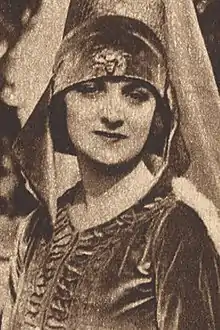Aimée Dalmores | |
|---|---|
_(14582733790).jpg.webp) Aimée Dalmores, from a 1917 directory. | |
| Born | February 11, 1890 |
| Died | January 22, 1920 (aged 29) |
| Nationality | American |
| Occupation | actress |
| Years active | 1914–1920 |
| Known for | musical theatre, silent films |

Aimée Dalmores (February 11, 1890 - January 22, 1920), née Aimée Cerruti, was an Italian-born American actress in musical theatre and silent films.
Early life
Aimée Dalmores was born in Salerno, with the surname Cerruti, "of Neapolitan parentage."[1] She immigrated to the United States with her family at the age of five. She returned to Europe to study art in Paris.[2][3]
In 1920, Cerruti's parents lived at 309 East 144th Street in the Bronx.[4] James J. Cerruti, also at that address, was a stenographer and typist with the New York Department of Public Charities in 1916 and 1917.[5] James J. Cerruti was her brother; he had a career in the Army Signal Corps and later became an artist; he recalled his Italian immigrant parents and their home in the Bronx, and his sister "who ran away to be an actress".[6]
Career
Broadway appearances by Dalmores included roles in Dancing Around (1914-1915),[7] Josephine (1918),[8] and The Master (1918). Other stage credits included Taking Chances (1915),[2] The Unchastened Woman (1916),[9][10] Peace and Quiet (1916),[11][12] Anna Cora Mowatt's short play Fashion (1917),[13] and Fifth Avenue (1917). She was in the cast of The French Episode (1917), directed by Ben Ali Haggin, part of a pageant presented on Long Island, to benefit the American Red Cross during World War I.[14][15][16] In 1918 she was the leading lady of the Robins Stock company in Toronto,[17] where she starred in Broken Threads.[18] Her film roles were in silent pictures from 1917, Scandal, starring Constance Talmadge,[19] The On-the-Square Girl, written by Ouida Bergère,[20] and Madame Fifi.[21]
Dalmores considered beautiful costumes a "curse" in her profession, because they distracted audiences from her performance. "If I can only reach the point where the audience will say 'Doesn't she act well?" instead of 'Isn't her dress pretty?" I shall feel that I have accomplished something," she told a newspaper in 1918.[22]
Personal life
Dalmores died in New York City, from influenza, in 1920, and was survived by her parents. Her funeral was held at the Church of Our Lady of Mount Carmel in the Bronx.[4][23]
References
- ↑ Anne Archbald, "Types: Miss Aimee Dalmores A Dark Italian Type" Theatre Magazine (April 1918): 238-239.
- 1 2 "The Stage" Munsey's Magazine (June 1915): 106, 110.
- ↑ Daisy Dean, "News Notes from Movieland" Janesville Daily Gazette (July 17, 1917): 6. via NewspaperArchive.com
- 1 2 "Deaths". New York Clipper. January 28, 1920. p. 34 – via Illinois Digital Newspaper Collections
 .
. - ↑ Civil Service Commission of the City of New York, Minutes (September 27, 1916): 517.
- ↑ Judy Altman, "He's Getting Up in the World at 74 — the Art World, That Is" Philadelphia Daily News (September 6, 1966): 9. via Newspapers.com
- ↑ "Dancing Around at the Winter Garden" Columbia Daily Spectator (November 25, 1914): 5.
- ↑ "Virginia Harned to Return" Dramatic Mirror (January 12, 1918): 5.
- ↑ "Aimee Dalmores" The Theatre (April 1917): 209.
- ↑ Channing Pollock, "Tired of Being Tired" The Green Book Magazine (January 1916): 20.
- ↑ "New York is Waiting Impatiently Until Autumn to See Three New Plays; But One of These Four Actresses Will Be Faithful to New York This Summer" Vogue (July 15, 1916): 54. via ProQuest
- ↑ "Amusements" Evening Star (June 4, 1916): 20. via Newspapers.com
- ↑ "Republic: Drama League Matinee" The Theatre (March 1917): 150.
- ↑ "Miss Aimee Dalmores" New York Times (October 14, 1917): pictorial page 2. via Library of Congress

- ↑ Evan Evans, "Red Cross Pageant" Harper's Bazaar (December 1917): 54.
- ↑ "The American Stage Pays its Tribute to the American Red Cross" Vogue (November 15, 1917): 50. via ProQuest
- ↑ "Robins to Open Stock" New York Clipper (March 27, 1918): 16. via Illinois Digital Newspaper Collections

- ↑ "Remains with Robins Stock" New York Clipper (April 24, 1918): 27. via Illinois Digital Newspaper Collections

- ↑ "Latest Selznick Addition in 'Scandal'" Motography (September 8, 1917): 513.
- ↑ "Amusements" Rushville Daily Republican (September 24, 1917): 8. via NewspaperArchive.com
- ↑ "Miss Dalmores in World Film" New York Clipper (March 7, 1917): 32. via Illinois Digital Newspaper Collections

- ↑ "The Curse of Beauty" New-York Tribune (February 24, 1918): 32. via Newspapers.com
- ↑ "Reappearance of Flu Tying up Theatrical Business" New York Clipper (January 28, 1920): 3. via Illinois Digital Newspaper Collections
